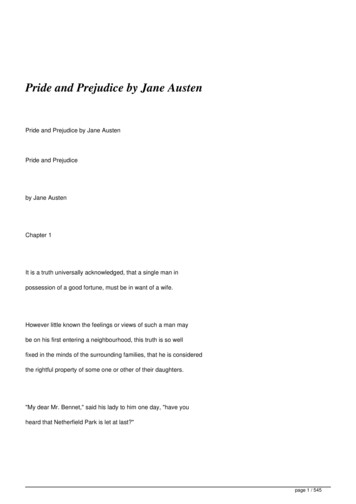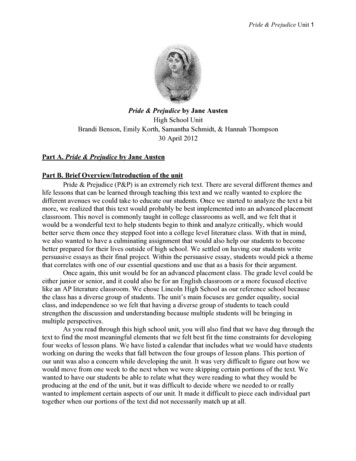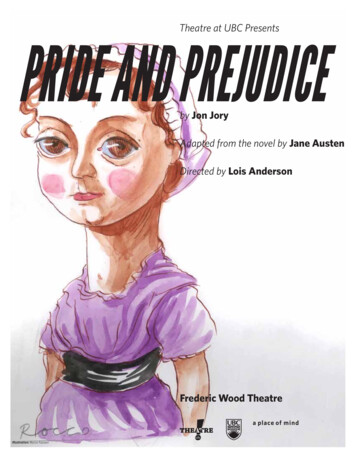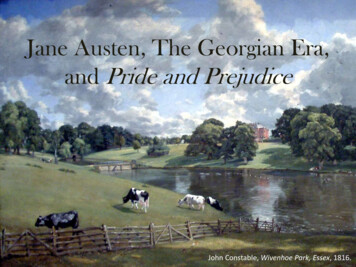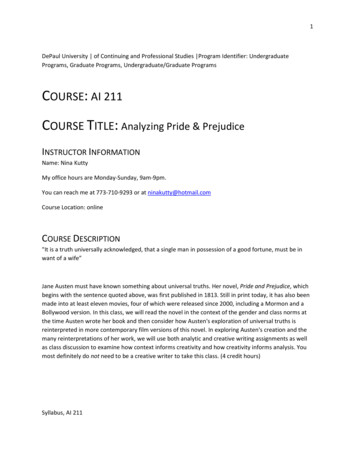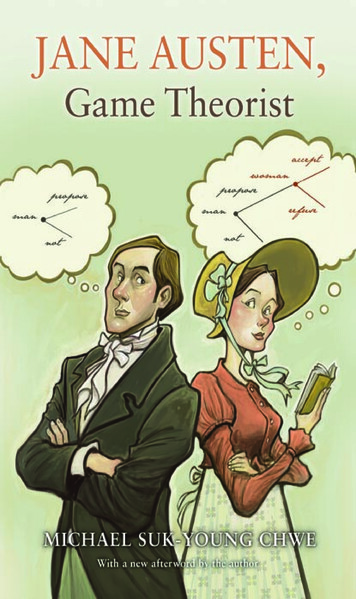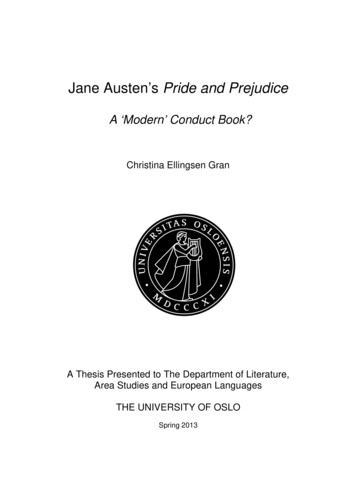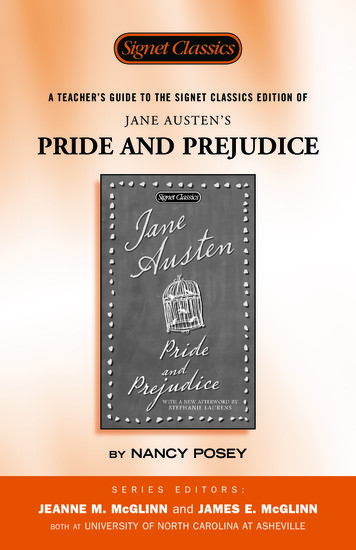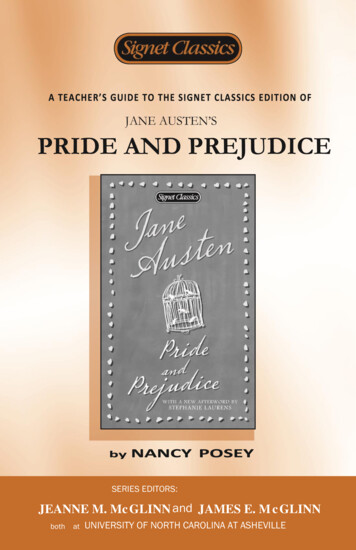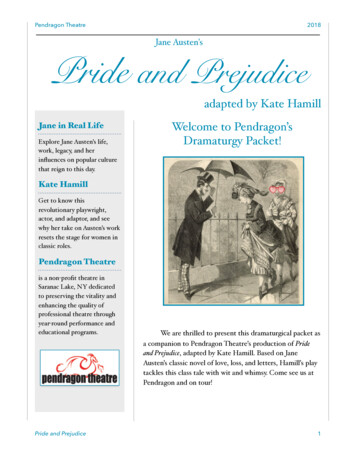
Transcription
Pendragon Theatre2018Jane Austen’sPride and Prejudiceadapted by Kate HamillJane in Real LifeExplore Jane Austen’s life,work, legacy, and herinfluences on popular culturethat reign to this day.Welcome to Pendragon’sDramaturgy Packet!Kate HamillGet to know thisrevolutionary playwright,actor, and adaptor, and seewhy her take on Austen’s workresets the stage for women inclassic roles.Pendragon Theatreis a non-profit theatre inSaranac Lake, NY dedicatedto preserving the vitality andenhancing the quality ofprofessional theatre throughyear-round performance andeducational programs.Pride and PrejudiceWe are thrilled to present this dramaturgical packet asa companion to Pendragon Theatre’s production of Prideand Prejudice, adapted by Kate Hamill. Based on JaneAusten’s classic novel of love, loss, and letters, Hamill’s playtackles this class tale with wit and whimsy. Come see us atPendragon and on tour!1
Pendragon Theatre2018Table of ContentsIntroduction .1About Kate Hamill 3Get to Know Jane .4Timeline 5P&P Through the Years 7Learn to Be a Lady .8Fun Facts .9The Business of Marriage 10Bibliography & Further Reading .11Primary Stagesensemble membersin Hamill’s Prideand PrejudicePride and Prejudice2
Pendragon Theatre2018Kate Hamill:Austenite ExtraordinaireKate Hamill is a playwright and actor from upstate New York who has a penchant for adaptingclassic novels to thrilling pieces of theatre that show modern audiences why these timeless tales resonate.Since graduating from Ithaca College, Hamill has frequently collaborated with Bedlam, a New York Citybased theatre company that produces new takes onclassic works. Hamill has adapted Austen’s 1811“I felt a strong sense of kinship with Janenovel Sense and Sensibility and 1814 novel MansfieldPark, premiering in October 2018. She has alsoAusten — an intense love for her work that’sgone on to shape my life ”adapted Willian Thackeray’s Vanity Fair and LouisaMay Alcott’s Little Women, in addition to her ownKate Hamill in “Love and Frustration”original works.Hamill has credited her pastoralupbringing with her affection for Austen, sayingthat her small town life cultivated her love of literature. Her plays have been produced Off-Broadway andall over the country, from Boston to Dallas. Hamill originated the role of Lizzy in Primary Stages’s Prideand Prejudice and has reprised the role various times since.The playKate HamillRumorsBorderline FarceWomen’s agency117 pagesSocietal pressuresJane AustenBorderlineMelodramaThe novel341 pagesPride and Prejudice3
Pendragon Theatre2018The Real Jane Austen“We are to have a tiny party here tonight.”Jane Austen in a letter, May 21, 1801One of the most prolific and well-known authors in modern history, Jane Austen was born onDecember 16, 1775 in Hampshire, England. Austen had six brothers but was closest with her sister,Cassandra — neither sister ever married. Though she only lived to be forty-one, Austen wrote six novelsand portions of others, some of which were published after her death in 1817.Austen first drafted the story FirstImpressions in 1797, and later reworked it into SensePride and Prejudice, published in 1812.Austen is remembered for writingindependent and outspoken women, and many ofher works discuss the limited roles available towomen in the Regency period. She originallypublished her writing anonymously, as womenwere not permitted to sign publishing contracts. In her lifetime, Austen acknowledged both the perceivedinferiority of the romance genre and her place as a woman writer of romance. “I could no more write aromance than an epic poem,” she wrote in a letter to English naval writer James Stanier Clarke in 1816. “Icould not seriously sit down to write a serious romance under any other motive than to save my life [ ] Iam sure I should be hung before I had finished the first chapter.” Even a writer as insightful andaccomplished as Jane Austen doubted her abilities, reflecting the internalization of her position as awoman in the society of landed gentry.Pride and Prejudice4
Pendragon Theatre2018A Timeline of Events1775December: JaneAusten borniHampshire1792Mary Wollstonecraft publishes AVindication of the Rights of Women,calling for the legalenfranchisement of women1795April: The US War ofIndependence begins1781The US defeatsBritish forces atYorktown, endingthe war1793Britain goes towar with FranceAusten drafts a story calledElinor and MarianneAusten meets Tom Lefroy,with whom she developed asemi-romantic friendship1797Austen’s father submits FirstImpressions (later reworked asPride and Prejudice) to a publisher,who rejects it1801The Act ofUnion createsthe UnitedKingdomPride and Prejudice1807The UKabolishes theslave trade5
Pendragon Theatre20181811Sense andSensibility ispublishedAusten begins torevise what becomesPride and Prejudice18121813Sense and Sensibility andPride and Prejudice both gointo second printingsPride andPrejudice ispublished1817Austen dies at theage of forty-one1818Austen’s family submits hernovels Northanger Abbey andPersuasion for publication“Pride relates more to ouropinion of ourselves, vanity towhat we would have othersthink of us”Jane Austen, Pride and PrejudicePride and Prejudice6
Pendragon Theatre2018Pride and PrejudicePage, Stage, Screen, & Science1036:Helen Jerome creates a staged version that playedat St. James Theatre in London1940:Robert Leonard directed movie adaptationstarring Laurence Olivier and Greer Garson1980:5-Episode BBC TV series starring Elizabeth Garvieand David Rintoul directed by Cyril Coke1995:Simon Langton directs 6-Episode BBC TV seriesstarring Colin Firth and Jennifer Ehle2008:Jane’s Austen’s Pride and Prejudice: A New Musical byLindsay Warren Baker and Amanda Jacobs ispresented in concert in Rochester, NY2009:2010:2011:2012:2013:2017:Pride and PrejudiceJennifer Ehle and Colin Firthin Simon Langton’s 1980miniseriesSeth Grahame-Smith’s Pride and Prejudice andZombies is releasedScientists name a pheromone identified in mouseurine darcin after Darcy as it attracts femalesThe opera Stolthet och fördom was written andcomposed by Daniel Nelson based on P&P.Popular web miniseries The Lizzie Bennet Diaries isreleasedJo Baker’s novel Longbourn imagines the lives ofthe servants of Pride and PrejudiceKate Hamill’s adaptation premiers at Primary Stagesin NYC7
Pendragon Theatre2018Life as a Lady in Regency Britain Women had to rely on men socioeconomically, but women largely outnumberedmen due to infant mortality rates for boys and girls Divorce in this time period was almost impossible for women to obtain Women were expected to only use their education in the private sphere, that iswhen entertaining guests. As a member of the landed gentry, Austen was brought up to study the arts, addressadults as “sir” or “madam”, and marry a man of her same social status Austen was concerned with the propriety in her niece Anna’s writing, calling herdialogue “too familiar and inelegant” While the rules of etiquette were meant to be followed, men who harped on suchrules in public were considered snobbish Women could not inherit their father’s property; this dilemma is central to the theCollins affair in both the play and the novel.This BBC game explores women’s rights inthe UK from the Victorian era on. You canplay at http://www.bbc.co.uk/history/trail/victorian britain/women home/act womens rights entry.shtml.Pride and Prejudice8
Pendragon Theatre2018Did you know ? Austen cited fellow Englishwoman novelist Fanny Burney as an inspiration, andoften mentioned Burney’s novels in her own Austen also loved the work of poet William Cowper While many of Austen’s romantic-inspired novels rejected melodrama, she indulged themes of gossipthat paralleled operas, which were considered an extension of the melodramatic formPage 28 Members of Austen’s social class were more fond of ballad operas than traditional Italian ones,and this is reflected in Austen’s many poetic and musical allusionsJane Austen continued to imagine how the lives of her characters evolved long after she finished anovel In A Memoir of Jane Austen, her nephew, James Edward Austen-Leigh discusses how after the events ofP&P, Kitty Bennet eventually married a clergyman near Pemberley while Mary ended up with a clerkwho worked for their Uncle Philips.Renee Zellweger, ColinFirth, and Hugh Grantin Bridget Jones’s Diary,loose telling of Austen’snovel.Pride and Prejudice9
Pendragon Theatre2018The Business of MarriageFrom Austen to TodayThe following is excerpted from Seattle Repertory Theatre’sstudy guideMr. Darcy is a highly sought-after bachelor because he makes 10,000 a year. It probably goes without saying that 10,000a year in 1813 is not equivalent to the same amount in 2017.During Austen’s time, the men were inheritors of land. Theywould then make money off this land by charging farmers towork it and then investing those profits in other land-owningand financial endeavors. In this way, the most successful men were able to allow their land holdings towork for them, thereby never need- ing to hold down a steady job themselves. Since the amount of moneyyour family had determined where you could go, who you could be friends with, and even who youmarried, it was very important to be wealthy. Eric Nye, an English Professor at the University ofWyoming, devised a currency calculator that converts currency values from the past into present daydollars. Please refer to the chart below to get a conversion of the yearly salary of characters in Pride andPrejudiceCharacterMr. DarcyWages in Austen’s TimeConverted Wages 10,000 653,106.22Mr. Bingley 4,500 311,897.80Mr. Bennet 2,000 138,621.24 150 10,396.59ShopkeepersIn Austen’s England, marriage was necessary and a good match was considered essential, yet occasions tomeet eligible men and women were limited. Assemblies and balls provided an arena for introductions,Pride and Prejudice10
Pendragon Theatre2018thereby facilitating the opportunity for courtships to be pursued. The decorum of the participants at adance determined their worth as individuals. This display of individual worth was evaluated not only bypotential partners, but also by the spectators in the room, which included family and neighbors, andmarried couples. Once an individual was acknowledged a suitable dance partner by a member of theopposite sex, that identification is carried over into the individual’s suitability as a marital partner. Therelationships of Jane and Bingley, and Elizabeth and Darcy exemplify the formula of first establishingthemselves as suitable dance partners, paving the way for courtship, and triumphing in marriage.Balls and BallsA Brief Overview of Regency Era Pastimes and Social PracticesDancesDancing was an important social skill and a necessary accomplishment of a lady or gentleman.The Duke of Wellington was reputed to insist that all his officers could dance, and to quote from one ofLord Chesterfield's letters to his son, "Dancing is in itself a very trifling, silly thing; but it is one of thoseestablished follies to which people of sense are sometimes obliged to conform, and then they should beable to do it well."Dancing was also, of course, the recognized way to meet young eligible partners and escape for amoment from the watchful eye of their chaperones. The great countryhouses held lavish balls and every middle-sized town with anypretensions to gentility had its own Assembly Room where balls mightbe 'got up by subscription'. Because the old custom of presentingdebutantes at court had fallen out of practice, daughters were presentedto society at the grand balls and assemblies of the London season.Lady’s PastimesYoung ladies of the Regency period were usuallytrained in some sort of craft or needlework bytheir mother or governess. Indeed, they oftenpossessed fancy workboxes or bags into whichwent the needles, threads, and the other implements for “Genteel Females” touse. It was amazing all it could hold. It was the receptacle for the much-workedon sampler, a labor on which many young girls practiced cross stitch and otherkinds of stitches. Some samplers were worked in wool thread. Many of thesamplers were worked in colorful silk threads. Most had the alphabet with amotto or verse, initials and date of embroideryon them. These samplers were most often a wayfor a girl to show she had learned her stitches.Pride and Prejudice11
Pendragon Theatre2018Archery, once a critical skill for protection and hunting, fell out of fashion in England sometime inthe 1500s to be resurrected en masse by the upper classes as sport in the late 1700s. By the Regency era,it was an established pastimes for gentlemen and women. It was particularly popular with the ladiesbecause it provided an opportunity to show off their figures, flirt, and mingle with men.Children’s GamesSkipping rope was a common pastime for both boy and girls. In fact, during themedieval era, only boys skipped rope as strenuous exercise was not consideredhealthy for girls. During the Regency era though, girls clearly enjoyed the sport aswell.Hopscotch is another equally ancient game. It may have originated in ancient Rome,but was certainly popular in the 17th century. In the game, players draw out a grid ofnumbered rectangles in a specified pattern. They toss a small object into thenumbered spaces and hop or jump through the spaces to retrieve the object.Continuing the theme of ancient games, children of both sexes enjoyed the game ofbattledore and shuttlecock, a predecessor of badminton. . Drawings from ancientGreece suggest this game originated there over 2000 years ago. Players, armed withrackets, tried to bat a feathered shuttlecock back and forth, without a net, and keep it in play as long aspossibleGirls risked little fatigue with the game of lawn bowls, a game originating in the 13th century. In thisgame, the objective was to roll balls so they would stop close to a smaller ball. The game was prohibitedby multiple monarchs including Edward III and Richard II for fear it mightimpinge on the practice of archery.As for indoor toys, toy theaters complete with doll house like stage andbackdrops and metal or paper characters were also comments. Children could actout familiar stories for their playmates or their families. Creative children mightwrite their own stories or even draw or paint their own characters for theirminiature stages.Marble games appeared to have developed during the same period. Marbles havebeen made of a variety of material including clay, stone metal and glass. Likejacks, a wide variety of games may be played with these prized objects. At Oxfordand Cambridge, students had to be prohibited from playing marbles on the stepsof the Bodleian Library and Senate House.Pride and Prejudice12
Pendragon Theatre2018This dramaturgical packet was compiled by Josh Bennett, Kenya Bullock, Kaliph Brown, Noah Fusco,Lissy Gold, Leah Guzick, Mia Merrill, Ashley Tang, and Solomon Zisser, and edited by Mia Merrill andJosh Bennett for Pendragon Theatre.BibliographyAusten, Jane. Sense and Sensibility.Austen, Jane. Pride and Prejudice.Deresiewicz, William. Jane Austen and the Romantic Poets. New York: Columbia University Press, 2004.Goldstein, Jack, and Isabella Reese. 101 Amazing Facts about Jane Austen. Andrews UK, 2014.Hamill, Kate. “Love and Frustration.” Bedlam’s Sense & Sensibility Toolkit, American Repertory Theater, 2017,pp. 35-36.Hamill, Kate. Pride and Prejudice. Dramatists Play Services, Inc., 2017.Jane Austen Centre, The. “Jane Austen’s Social Background.” janeausten.co.uk.Jane Austen Society of North America. “Jane Austen’s Works.” jasna.org.kate-hamill.com.McAlpine, Fraser. “The Brits and Cross-Dressing: A History.” BBC America, 2015.Nigro, Jeffrey A. and Andrea Cawelti. “Divas in the Drawing Room, or Italian Opera Comes to Highbury.”Persuasions: The Jane Austen Journal Online, vol. 37, no. 1, 2016.Ross, Josephine, and Henrietta Webb. Jane Austen’s Guide to Good Manners: Compliments, Charades & HorribleBlunders. New York: Bloomsbury USA, 2006.Martinez-Vasquez, Ariene. Pride and Prejudice Play Guide. Seattle Repertory Theatre, 2017.Further Reading“Interview with Sense & Sensibility Playwright Kate Hamill” by Folger Theatre, https://spotlight.folger.edu/2016/10/07/interview- w: A Whirlwind of Delicious Gossip in ‘Sense and Sensibility’ by Ben Brantley, ty.html.Pride and Prejudice13
Pendragon Theatre2018“‘Sense and Sensibility’ playwright Kate Hamill on adapting Jane Austen and making work for women’ byPamela Espeland, d-sensibility-playwright-kate- hamilladapting-jane-austen-and-making-work-w.The Making of Jane Austen by Devoney Looser, Johns Hopkins University Press, 2017.Pride and Prejudice14
a companion to Pendragon Theatre's production of Pride and Prejudice, adapted by Kate Hamill. Based on Jane Austen's classic novel of love, loss, and letters, Hamill's play tackles this class tale with wit and whimsy. Come see us at Pendragon and on tour! Pride and Prejudice 1 Jane in Real Life Explore Jane Austen's life, work, legacy .
